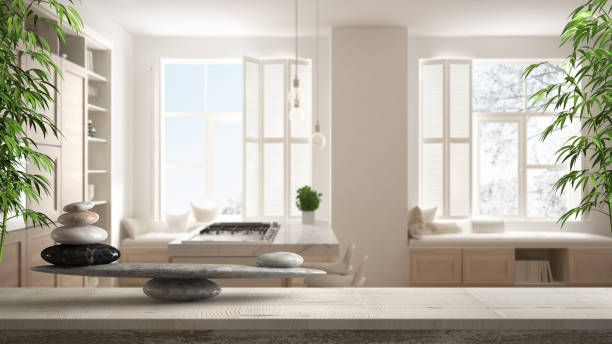Feng Shui Basics
Importance of Feng Shui in Home Design: How to Create Balanced and Positive Environments
Feng Shui, the ancient Chinese practice of harmonizing individuals with their surrounding environments, has transcended centuries and remains relevant in modern home design. Rooted in the belief that the arrangement of spaces can influence one’s well-being, success, and happiness, Feng Shui is increasingly sought after by homeowners looking to create balanced and positive living environments.
By applying the principles of Feng Shui in home design, you can improve the flow of energy, or “Chi,” and ensure that your home fosters a sense of tranquility, health, and prosperity. This article explores the significance of Feng Shui in home design and offers practical tips on creating a harmonious and positive living space.
1. The Role of Energy in Feng Shui
The concept of energy, known as Chi, is central to Feng Shui. In home design, Chi is the invisible force that flows through the spaces and influences every aspect of life. The balance and flow of this energy can have a profound effect on the inhabitants, shaping their emotions, health, and even their fortune.
How to Apply It:
- Encourage Movement: Furniture and decor should be arranged in a way that encourages the smooth flow of energy. Avoid blocking pathways or creating cluttered spaces that could cause stagnation or disrupt the flow of Chi.
- Maximize Entry Points: Ensure that your home’s entryway is clean, uncluttered, and welcoming. The entrance is considered the gateway for energy, and its condition can set the tone for the entire home.
2. Feng Shui in Home Design: Creating Balance and Harmony
Feng Shui emphasizes the importance of balance in design. This balance is achieved through a careful combination of elements, colors, shapes, and materials, all of which work together to create an environment that feels peaceful and in tune with nature.
How to Apply It:
- Yin and Yang Balance: In Feng Shui, the interplay of Yin (passive, calm) and Yang (active, vibrant) energies is essential for harmony. Incorporate soft, cozy furnishings for Yin energy in areas meant for relaxation, like bedrooms, while using bold colors and dynamic elements in living rooms or workspaces to promote Yang energy.
- Use of the Five Elements: Balance the five elements—Wood, Fire, Earth, Metal, and Water—throughout your home to ensure the spaces feel harmonious. For instance, bring in Earth elements like clay pots in the kitchen and use Water elements like a small fountain in a meditation space.
3. The Bagua Map: Designing for Life’s Key Areas
The Bagua map is a Feng Shui tool used to align different areas of a home with specific aspects of life, such as wealth, health, career, and relationships. By applying the Bagua map, you can design spaces that support your life goals, from improving your financial well-being to fostering stronger personal connections.
How to Apply It:
- Divide Your Space: Use the Bagua map to divide your home into zones that represent different life aspects. For instance, the southeast corner of your home represents wealth, so adding green plants or a water element to this area can promote prosperity.
- Enhance Key Areas: Focus on enhancing areas of your home that correspond to the aspects of life you want to improve. For example, place family photos or symbols of love in the relationship corner to strengthen bonds.
4. Furniture Placement for Positive Energy Flow
Feng Shui offers guidance on furniture placement, which can have a significant impact on how a space feels and functions. Properly positioned furniture not only enhances the flow of energy but also creates a sense of security and comfort.
How to Apply It:
- Command Position: In Feng Shui, furniture like beds and desks should be placed in the “command position,” meaning they face the door without being directly in line with it. This position allows you to feel safe, aware, and in control of your environment.
- Avoid Sharp Corners: Arrange furniture so that sharp corners are not pointed toward areas where people sit or sleep. Sharp angles can create negative energy, so soften the space with rounded furniture or plants.
5. Colors and Feng Shui: The Impact of Color on Energy
Colors are powerful in Feng Shui, as each color is associated with one of the five elements and carries specific energy. The colors you choose for your home can influence your mood, emotions, and overall well-being.
How to Apply It:
- Choose Colors Based on Intentions: Select colors that align with the energy you want to cultivate. For example, green is associated with growth and healing, making it a great choice for living rooms or health-related spaces. Meanwhile, red, associated with passion and energy, might be used in areas where you want to stimulate activity.
- Balance Color Energy: Be mindful of balancing colors in a space. For instance, too much red can be overwhelming, so balance it with softer, neutral tones like beige or white to create harmony.
6. Clutter-Free Spaces: Enhancing Flow and Positivity
A core principle of Feng Shui is the importance of decluttering. Clutter creates stagnant energy and blocks the flow of Chi, which can lead to feelings of stress, confusion, or dissatisfaction. Keeping your home organized and clutter-free is essential for maintaining a positive and peaceful environment.
How to Apply It:
- Clear Surfaces: Keep surfaces like countertops, tables, and desks free of unnecessary items. This allows energy to flow smoothly and encourages productivity and peace of mind.
- Organize Closets and Storage: Ensure that closets, cabinets, and drawers are organized and not overstuffed. Hidden clutter can still negatively impact energy flow, so it’s essential to maintain organization throughout the home.
7. Bringing Nature Indoors: The Role of Plants in Feng Shui
Plants play an essential role in Feng Shui as they symbolize growth, vitality, and renewal. Incorporating plants into your home design not only enhances the aesthetic appeal but also contributes to positive energy by connecting your space to nature.
How to Apply It:
- Healthy Plants for Healthy Energy: Choose vibrant, healthy plants to fill your home with life and positive energy. Plants like bamboo, peace lilies, or jade plants are popular choices in Feng Shui for their uplifting qualities.
- Place Plants Strategically: Position plants in areas that need energy or vibrancy, such as corners or near windows, to draw in light and fresh air.
Conclusion: The Transformative Power of Feng Shui in Home Design
Feng Shui is more than just an approach to interior design; it’s a philosophy that seeks to enhance the energy of your living spaces and, in turn, improve your overall well-being. By integrating the principles of Feng Shui into your home design, you can create balanced, harmonious environments that foster positive energy, promote health, and attract prosperity.
Whether you’re designing a new home or looking to make changes to your current space, the application of Feng Shui principles can guide you in creating a home that not only looks beautiful but also feels balanced and supports your personal growth and happiness.

